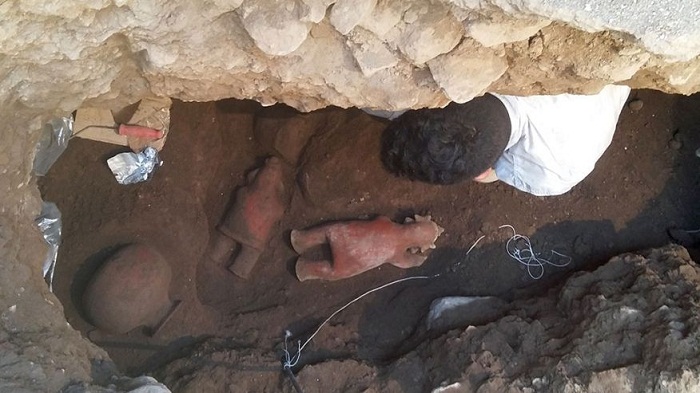Inside, 12 skulls and other bones were piled atop one another in a haphazard manner. Some of the skulls showed signs of damage, as well as tooth fractures and wear, said Rosa María Flores Ramírez, a physical anthropologist at the National Institute of Anthropology and History (INAH) in Mexico.
When the archaeologists explored further, they discovered three burial levels. In the second burial level, the team found two figurines — a male and female — placed facedown next to two skulls.
Ancient figurines
The male figurine, which measures 15 inches tall and 6 inches wide, was wearing an elaborate headdress with a horn jutting out from it. In his hand, he holds an ax.
The female figurine, which is 12.5 inches by 5.5 inches, shows a woman with a sharp nose and a triangular head. She wears a banded headdress and has her hands crossed, with the right hand holding a pot. The burial also contained two other pots.
Each of the figures was sculpted from fine paste that was polished when complete. The ancient artists used cuts to etch in the facial features.
"The presence of these pieces in the offering hint at the worldview of the groups that inhabited the Colima valley in that period. The sculptures, according to their attributes, served as propitiatory elements that ensured the protection of the deceased, as is the case with the male sculpture, which represents a shaman. The other objects fulfilled the function of bringing the requirements to the underworld," Rafael Platas Ruíz, an archaeologist at the INAH, said in a translated statement .
The finding is rare because tombs of this type are almost invariably looted before archaeologists can get to them.
The fact that the tomb was untouched "allowed us to have a first approach with the bone remains, to observe the lesions, deformations and to have more information to know what was their way of life," the researchers said in the statement.
It`s possible that this isn`t the only burial in the area, because the entire Colima valley was occupied continuously from 1500 B.C. to A.D. 1500, and cultural relics from different periods in the city`s history may be lying beneath it, the researchers said.
/Live Science/
More about:
















































